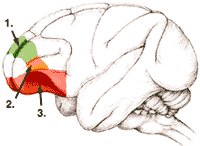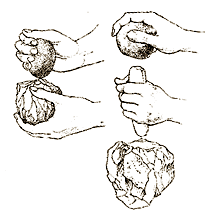|
context weblog 2001 |
|
| home | site map | about context | lang >>> español | |
|
>>> context weblog |
|
|
|
|

|
|
|
|

|
composite tool-making and evolution "Grammatical language, planning complex tasks and composite tool use were closely related," Stanley Ambrose said. "The ordering of sequences and the hierarchical assembly of the same components into different configurations makes tools of different functions and makes phrases of different meanings." "Gathering the components for composite tools (stone inserts, handles, binding materials) requires planning and coordinating different tasks before a tool is assembled. "The part of the frontal lobe that we now use for planning complex tasks may have coevolved with composite tool-making around 300,000 years ago." "As makers of single-component tools, we progressed at a remarkably slow pace between 2.5 and 0.3 million years ago. But "with the appearance of composite tools, near-modern brain size anatomy and perhaps of grammatical language 300,000 years ago, the pace quickened exponentially. We became long-range planners and grammatical speakers. Composite tools made us what we are today." (From *Expert proposes new ideas about technology and evolution*. March 1, 2001.) |
| |
|
what makes us humans A new study has found the strongest evidence yet that what sets humans apart from other primates may be found in the brain's frontal lobes, particularly in an area called the right prefrontal cortex. Study was led by Dr. Donald Stuss at The Rotman Research Institute, and affiliated with the University of Toronto. Published in the February 2001 issue of the international journal BRAIN. "Understanding the mental processes of others -- mentalizing -- is the basis of our socialization and what makes us human. It gives rise to our capacity to feel empathy, sympathy, understand humor and when others are being ironic, sarcastic or even deceptive. It's a "theory of mind" that has been associated with the frontal lobes, but until now scientists have had difficulty demonstrating this ability to specific regions of the brain." (From *Study pinpoints region in frontal lobes as 'essence' of what makes us human*, January 31, 2001.) "I think that an important clue to the human mystery lies in the fact that virtually all prefrontal capacities -- working memory, theorizing about other people's minds, our sense of self -- unfold gradually over the first two decades of life. So too, the human prefrontal cortex is distinctive in how long it takes to develop, continuing well into adolescence. I suspect that the key to building a human lies in letting the world help build the prefrontal cortex as it experiences the world. If this is so, then the interaction between brain and world is a far richer one than ever imagined, and crucial to understanding who we are." (From *Steven Quartz on the Prefrontal Cortex* |
|
|
|
|
|
|
|
source :: |
Expert proposes new ideas about technology and evolution. :: references :: grafik |
|
|
|
|
| home | site map | about context | lang > español | |
context weblog >>> http://www.straddle3.net/context
 *
technology and evolution
*
technology and evolution